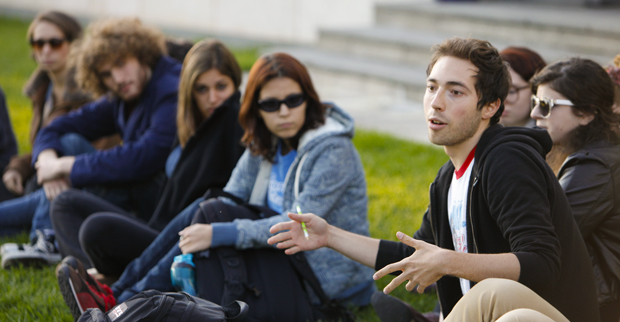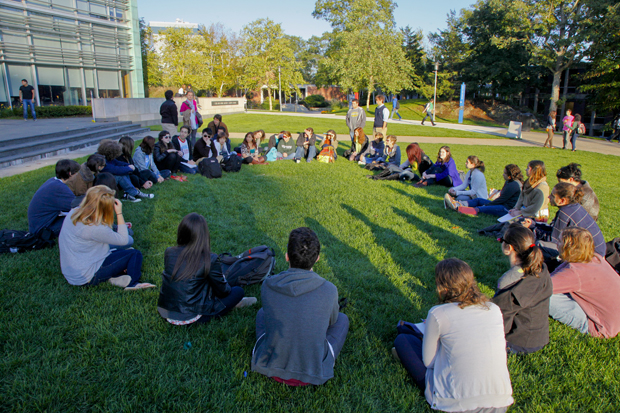'Occupy' movements ignite some campus activists
Effort launched to encourage and organize Brandeisians
 Photos/Mike Lovett
Photos/Mike LovettShea Riester '12 encouraging Brandeis student involvement in Occupy Boston movement.

Students gathered for an information session on the Great Lawn.
Brandeis students gathered on the Great Lawn on Thursday afternoon to plan logistics and actions in support of the Occupy Wall Street/Occupy Boston movements for this weekend and beyond.
Hanna Wellish’12, a Brandeis student who first became involved when she answered a Facebook page calling for students to join the action at Wall Street, said the response was good and many students came to learn what is really happening.
Vans were arranged by individual students to transport anyone who was interested to Dewey Square to join in the protest immediately after the meeting.
 |
| How it began Sept. 17: A mass of New Yorker’s brandishing banners claiming that “We are the 99%” march through the financial district in Lower Manhattan, fueled by dissatisfaction with politics, the economic state of affairs and the power of the corporate world. Sept. 23: More than 100 protestors descend on Zuccotti Park, rename it Liberty Plaza and erect a huge maze of tents and tables. They named their movement “Occupy Wall Street” Sept. 30: Two hundred activists gather outside Boston’s Federal Reserve Bank in Dewey Square, officially launching the first general meeting and protest of Occupy Boston. Oct. 3: Flyers appear all over the Brandeis campus, telling students “you are the 99 percent” and urging them to join hands with Occupy Boston. |
 |
Wellish and Shea Riester’12, who has spent time at both Occupy Wall Street and Occupy Boston, are among students encouraging support for the Occupy movement within the Brandeis community. They say that in the days to come the Occupy group at Brandeis hopes to recruit more student activists, create more visibility for the cause and get more students to Occupy Boston.
“This is the most important issue right now,” Wellish said. “If you get to participate in this conversation for change, it’s a really remarkable, energizing feeling.”
Occupy Boston is being carried out using the mold Occupy Wall Street created. As at Zuccotti Park, Dewey Square is now home to a small, functioning city, Wellish said, noting that there is a medical area, a food area, a library, a sleeping area and a media relations section.
General assemblies are held every day where anyone can speak out about their issues, she said, calling it “a learning and teaching environment with constant discussion – it is the most democratic thing I have ever seen.”
Occupy Wall Street and its offshoots in other cities have come under media fire for being an unconstructive method of expressing dissatisfaction. A New York Times column, for example, recently focused on a "half-naked woman” protestor in Zuccotti Park, claiming that she was symbolic of the lack of intellectual substance within the movement. Other critics complain that the protesters do not have specific demands or goals which, if achieved, would put an end to the protests.
In response, Riester compares this cause to the civil rights movement: “It never started with one specific demand, it started with dissatisfaction.”
For him, the emphasis is not on tangible outcomes but on spreading an awareness that large numbers of Americans are deeply unhappy with the way the power structure of the country is spending government funds, making war and dealing with working people. “For me, it’s not about having a list of structured demands,” Riester said, “it’s about being out there on the streets.”
Brandeis students and alumni were getting involved in the movement even before it hit the greater Boston area.
Naveh Halperin ’12 said engaging in Occupy Wall Street was “a no-brainer. It was a culmination of what I wanted to do for a very long time.”
Many students echo his sentiments; there has long been a deep-rooted dissatisfaction among students over the way America has been run and the resulting debt and economic hardships which have been inflicted on ordinary people. Now, Halperin says, “everyone knows someone who has lost a job, or their mortgage, or is going through some great financial crisis.”
Wellish said a main reason the movement is gaining popularity and spreading swiftly is that it accommodates a broad range of critiques of the current situation. “Any issue that you could possibly have been passionate about with regard to the eco-political atmosphere of the country, all come under the umbrella that is Occupy Wall Street,” she said.
Wellish expressed great respect and admiration for the way in which protests are being organized, especially in the absence of any figurehead or leading group. “It’s not an anarchist riot 24/7 as most media coverage would have you believe,” she said. “If anything it’s a community with many different parts working together.”
Categories: General, Student Life






